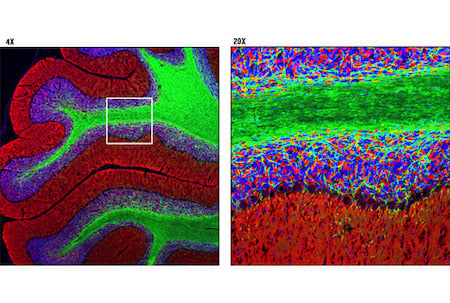Cellular homeostasis is regulated by the coordinated activity of several key metabolic pathways. These processes, which include carbohydrate metabolism, lipid metabolism, glutamine metabolism, and nucleotide metabolism, maintain the energetic status of cells and provide the necessary building blocks to ensure proper cellular function. In turn, many of these metabolic pathways are regulated by extracellular signaling. For example, insulin acts as the major hormone controlling critical energetic functions like glucose and lipid metabolism by acting through its cognate receptor.
Carbohydrate Metabolism
Carbohydrate metabolism encompasses all of the biochemical processes responsible for the formation, breakdown, and interconversion of carbohydrates, molecules composed of carbon, hydrogen, and oxygen (CHO), to ensure a constant supply of energy to living cells.

α-amylase is a calcium metalloenzyme that aids in digestion by breaking down long-chain carbohydrates, or polysaccharide molecules, into smaller ones such as starch and glucose. Above: Immunohistochemical analysis of paraffin-embedded human pancreas using α-Amylase (D55H10) XP Rabbit mAb #3796.
- Glucose, the primary substrate for metabolism, is absorbed into the bloodstream in the small intestine and circulated to all tissues in the body where uptake is regulated by insulin signaling to provide much of the daily energy needs of an individual.
- Glucose is further broken down into pyruvate via glycolysis, a process that yields a net production of adenosine triphosphate (ATP), a vital source of energy for living cells.
- ATP is converted to the polysaccharide glycogen via glycogenesis primarily in the liver and skeletal muscle, where it serves as an emergency fuel reserve that can be subsequently released as free glucose by glycogenolysis.

Explore the interactive Warburg Effect Pathway Diagram, along with associated CST antibody products.
Insulin Signaling
Insulin is the major hormone controlling critical energy functions including glucose and lipid metabolism.
- Insulin binds to and activates the insulin receptor tyrosine kinase which initiates downstream signaling principally through the PI3K/AKT and ERK1/2 pathways following the phosphorylation and recruitment of substrate adaptors including the IRS family of proteins.
- Maintains glucose homeostasis by stimulating the uptake of glucose by fat and muscle cells and reducing the synthesis of glucose in the liver.
- Insulin secretion from the pancreas is modulated by blood glucose levels.

Explore the interactive PI13/AKT Pathway Diagram, along with associated CST antibody products.

Explore the interactive Insulin Receptor Signaling Pathway Diagram, along with associated CST antibody products.
Lipid Metabolism
Lipid metabolism encompasses biological processes involved in the synthesis or degradation of lipids, a class of organic compounds including fatty acids or their derivatives that are insoluble in water but soluble in organic solvents.
 |
 |
| Immunohistochemical analysis of paraffin-embedded mouse liver using Phospho-Acetyl-CoA Carboxylase (Ser79) (D7D11) Rabbit mAb #11818. | IF analysis of HeLa cells using Fatty Acid Synthase (C20G5) Rabbit mAb #3180 (green). Actin filaments have been labeled with DY-554 phalloidin (red). Blue pseudocolor = DRAQ5™ (fluorescent DNA dye). |
- Lipids serve as building blocks for key cellular structures (e.g., membranes), function in many cell signaling networks, and are energy-rich fuel sources used to support cellular functions.
- Complex lipids called triglycerides are broken down during digestion in the mouth and small intestine by enzymes called lipases and transported through the blood by lipoproteins.
- Fatty acids are both a source of and a storage unit of energy in the cell. Fatty acids are synthesized in the cytosol of cells from Acetyl-CoA and NADPH in a process catalyzed by fatty acid synthases and are subsequently metabolized into phospholipids that serve as the major component of cellular membranes and also function in cell signaling pathways.

Explore the interactive AMPK Signaling Pathway, along with associated CST antibody products.
Glutamine Metabolism
The amino acid glutamine is an important metabolic fuel that helps rapidly proliferating cells meet the increased demand for ATP, biosynthetic precursors, and reducing agents.
- Glutamine is the most abundant free amino acid in circulation and in intracellular pools.
- Acts as a substrate to meet the increased demand for ATP, biosynthetic precursors, and reducing agents in dividing cells.
- Specific amino acid transporters enable glutamine to enter cells where it is then converted to glutamate in the mitochondria which serves as a precursor to the TCA cycle intermediate α-ketoglutarate.
- Cancer cells are often dependent on glutamine metabolism to meet increased energy demands.

Explore the interactive Glutamine Metabolism Pathway, along with associated CST antibody products.
Nucleotide Metabolism
Nucleotide metabolism is the series of biochemical reactions necessary for the synthesis and degradation of the basic building blocks of nucleic acids, DNA, and RNA.
- Purines (adenine and guanine) and pyrimidines (cytidine, uridine, and thymidine) are the two major groups of nucleotides. All nucleotides are composed of a pentose sugar and phosphate group, but purines and pyrimidines differ in the size of their nitrogenous base.
- Nucleotides in the form of nucleoside triphosphates (ATP, GTP, CTP, and UTP) serve as stores of chemical energy required for many cellular functions including amino acid and protein synthesis, cell migration, and division, that is released via phosphate removal.
- Cyclic nucleotides, cGMP and cAMP, act as key second messengers in many cell signaling cascades that are modified by a class of enzymes called cyclic nucleotide phosphodiesterases.
 IF analysis of rat cerebellum using CNPase (D83E10) XP® Rabbit mAb #5664 (green) and α/β-Synuclein (Syn205) Mouse mAb #2644 (red). Blue pseudocolor = DRAQ5® #4084 (fluorescent DNA dye).
IF analysis of rat cerebellum using CNPase (D83E10) XP® Rabbit mAb #5664 (green) and α/β-Synuclein (Syn205) Mouse mAb #2644 (red). Blue pseudocolor = DRAQ5® #4084 (fluorescent DNA dye).
Additional Resources
Learn more about cellular metabolism in our brochure:
20-ODA-41951






/42157_chimeric%20antibody%20blog%20featured3.webp)
